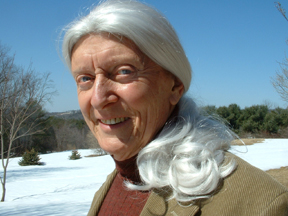 As
a young man fresh from college almost half a century ago, Sam Adams became an
expert in uranium deposits in the Southwest, but the native New Hampshire geologist
says he is not a specialist in anything. Adams’ breadth of interests has
led him to serve not only the geologic community, but also the broader communities
in which he has lived, as a capable leader in the field, classroom and public
forums.
As
a young man fresh from college almost half a century ago, Sam Adams became an
expert in uranium deposits in the Southwest, but the native New Hampshire geologist
says he is not a specialist in anything. Adams’ breadth of interests has
led him to serve not only the geologic community, but also the broader communities
in which he has lived, as a capable leader in the field, classroom and public
forums.Former Geotimes Editor-in-Chief Sam Adams will receive the Ian Campbell Medal for service to the geologic community, at the annual meeting of the Geological Society of America this fall, from the American Geological Institute. Courtesy of Sam Adams.
Adams says he is “a hopeless geological generalist. … I was always fascinated with the breadth of the earth sciences.” That fascination was critical to studying mineral deposits and to his career “on the boundaries between things,” particularly between applied science and basic research science, he says. For his service to both communities, Adams will receive the Ian Campbell award this month from the American Geological Institute, which publishes Geotimes (for which Adams served as Editor-in-Chief from 2000 to 2005).
Although he did not know that geology existed as a field of study until he arrived at Dartmouth College in Hanover, N.H., Adams eventually realized that he was drawn to the subjects intrinsic to the earth sciences — more so than the pre-medical coursework he was following. One of his first industry experiences was as a summer employee, working in New Mexico for Don Everhart, the chief geologist and manager of exploration for International Minerals and Chemical Corporation (IMC), who eventually hired him permanently. “Sam was very creative, and always had new ideas,” Everhart says, from connections in the field to connections in theories of economic geology.
A professor from Dartmouth, where Adams did his undergraduate and master’s work, had recommended him to Everhart, who in turn recommended his own alma mater, Harvard, to Adams for his doctoral work. At Harvard, Adams says that he gained his love of low-temperature geochemistry and uranium deposits from Bob Garrels, “one of the masterminds” of these fields.
Firmly set on that geological path, Adams went back west to work again for IMC, and then for Anaconda, in Salt Lake City, Utah, where he focused on uranium deposits in New Mexico and worldwide. “What I apply from having worked with Sam,” says Dianne Nielson, Adams’ former employee at Anaconda and now executive director of Utah’s Department of Environmental Quality, “is the importance of getting out on the ground, seeing the problem firsthand, and sharing information with other scientists and people who need that information.” Adams stressed the importance of fieldwork, and one of his strengths was curiosity, she says. “He would be at home on any outcrop where there was a question to be unraveled.”
Eventually, Adams helped transition Anaconda to its new parent company, ARCO, in 1976, and then became a consultant based in Boulder, Colo. In 1986, he was recruited by the Colorado School of Mines in nearby Golden to be the head of the geology and geological engineering department. Dick Hutchinson, who headed the search committee and became a fast friend, calls Adams “an integrator” who, beyond his understanding of geological problems, understood people, which helped him knit together a “successful department.”
Adams’ “energy and enthusiasm for the science was certainly invigorating,” says Poul Emsbo, at the time Adams’ graduate student and now at the U.S. Geological Survey in Denver. Emsbo says that he is a geologist today because of Adams, whose teaching “capture[d] the imagination of his students.” Before the two knew each other well, Adams decided they had to check out Emsbo’s thesis area. “Sam got a vehicle and drove all the way through the night” to Nevada, Emsbo says, where they spent two days talking to industry representatives and looking at potential field sites. Then “we got back in the car, and drove straight through in time for his Monday meetings.”
Following his years out west in industry and teaching, Adams returned east, becoming president and general manager of New Hampshire’s largest ski resort, established by his family. There, he applied his people skills to improve the operation, Hutchinson says. Adams says he also used some of the same environmental principles that he first was introduced to while teaching at the Colorado School of Mines.
Now Adams and his wife Nancy have been teaching an entirely different subject. After one of their daughters was diagnosed with obsessive compulsive disorder, associated with her pregnancy, they began peer-counseling other families affected by mental illness, as well as taking part in related public-policy issues.
“My scientific background has been helpful in working through that,” Adams says, and teaching and working on these issues has been “immensely satisfying.” In 2003, he became president of the National Alliance for the Mentally Ill-New Hampshire, but had to step down due to a recent cancer diagnosis. Adams’ respect for all stakeholders, from family caregiver to treatment provider, was important, says Michael Cohen, executive director of the organization, in addition to his academic approach to mental health issues. Adams says that he and his wife will use their “new medical experiences” to teach doctors about patients’ needs.
Nielson, who has worked with Adams on various committees, including for the National Academy of Sciences, says Adams can “take science and translate it in ways that are understandable.” His ability to do so is an “inherent trait of being able to look from different perspectives.”
Naomi Lubick

